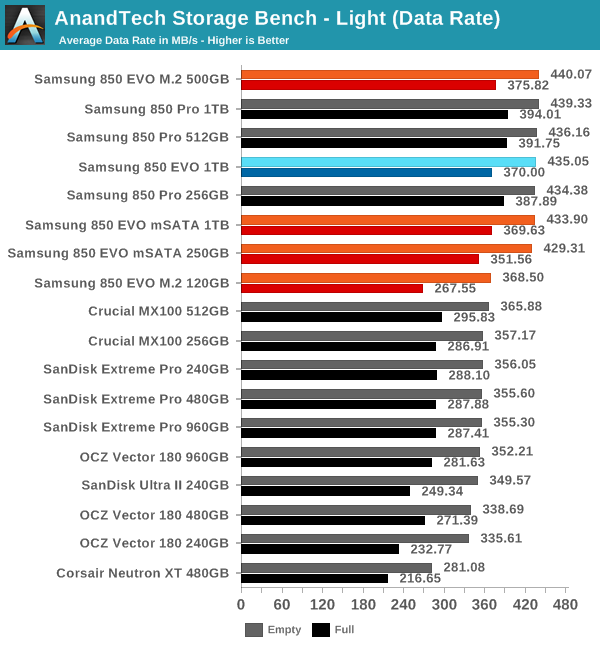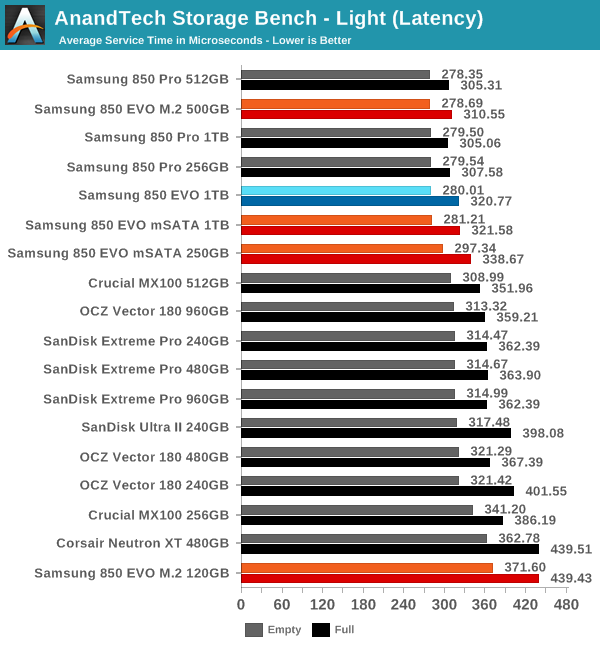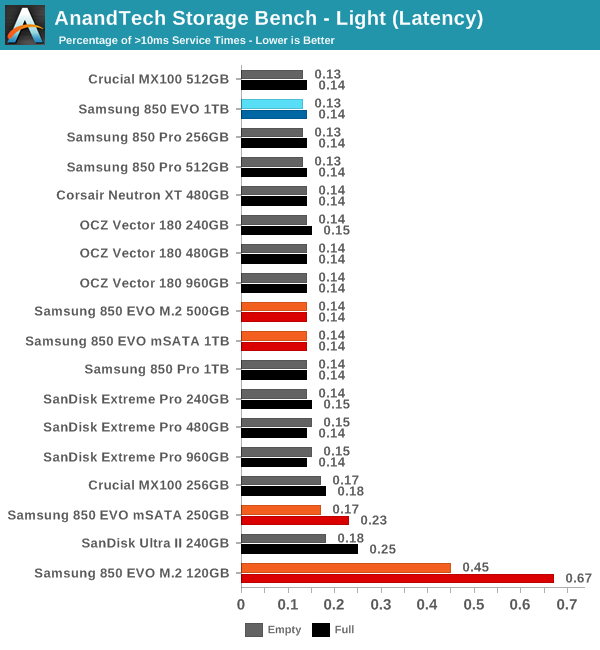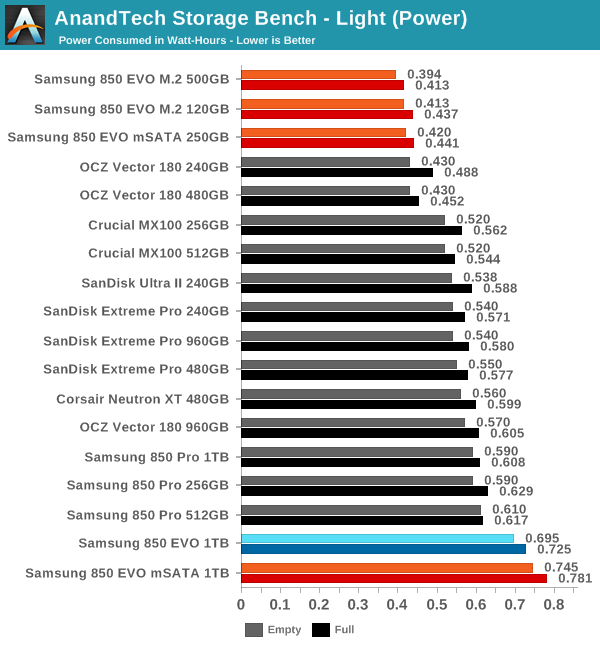The Samsung SSD 850 EVO mSATA/M.2 Review
by Kristian Vättö on March 31, 2015 10:00 AM ESTAnandTech Storage Bench - Light
The Light trace is designed to be an accurate illustration of basic usage. It's basically a subset of the Heavy trace, but we've left out some workloads to reduce the writes and make it more read intensive in general.
| AnandTech Storage Bench - Light - Specs | ||||||||||||
| Reads | 372,630 | |||||||||||
| Writes | 459,709 | |||||||||||
| Total IO Operations | 832,339 | |||||||||||
| Total GB Read | 17.97 GB | |||||||||||
| Total GB Written | 23.25 GB | |||||||||||
| Average Queue Depth | ~4.6 | |||||||||||
| Focus | Basic, light IO usage | |||||||||||
The Light trace still has more writes than reads, but a very light workload would be even more read-centric (think web browsing, document editing, etc). It has about 23GB of writes, which would account for roughly two or three days of average usage (i.e. 7-11GB per day).
| AnandTech Storage Bench - Light - IO Breakdown | |||||||||||
| IO Size | <4KB | 4KB | 8KB | 16KB | 32KB | 64KB | 128KB | ||||
| % of Total | 6.2% | 27.6% | 2.4% | 8.0% | 6.5% | 4.8% | 26.4% | ||||
The IO distribution of the Light trace is very similar to the Heavy trace with slightly more IOs being 128KB. About 70% of the IOs are sequential, though, so that is a major difference compared to the Heavy trace.
| AnandTech Storage Bench - Light - QD Breakdown | ||||||||||||
| Queue Depth | 1 | 2 | 3 | 4-5 | 6-10 | 11-20 | 21-32 | >32 | ||||
| % of Total | 73.4% | 16.8% | 2.6% | 2.3% | 3.1% | 1.5% | 0.2% | 0.2% | ||||
Over 90% of the IOs have a queue depth of one or two, which further proves the importance of low queue depth performance.

The 850 EVO also shines in our Light trace by being the fastest SATA drive we have tested along with the 850 Pro.

The latency is also great despite the capacity, so I have no problem recommending the 850 EVO for basic workloads -- it's only the heavier workloads that bring the smaller capacities to their knees.

Power is again excellent except for the 1TB model. I'm honestly a big surprised that the 850 EVO is so much more power efficient than the 850 Pro despite the fact that MLC NAND should be more power efficient by design.











58 Comments
View All Comments
Flunk - Tuesday, March 31, 2015 - link
This is what makes M.2 such an annoying standard. They tried to accommodate everything and ended up with compromises that don't make sense and will probably be written out of the standard in a future version.setzer - Tuesday, March 31, 2015 - link
Also don't forget about the single and double sided thing as noted in the article there are some laptops that only accept single-sided.Also there is nothing to prevent a manafucturer to put a B+M keyed M.2 socket but only connect the USB traces. See toshiba's Z30's laptops for a pratical example.
The joys of M.2 are great :P
ilkhan - Wednesday, April 1, 2015 - link
Answer: Ports should be wired and keyed for sata and pci-e.devices can be whatever they need.
The keys are there to prevent a pci-e device in a sata host.
rtho782 - Tuesday, March 31, 2015 - link
I still don't see a reason to replace my ageing 256GB Samsung 830s in RAID 0.I really want a decent PCIe NVMe M.2 or SATAe SSD of about 500GB, preferably Samsung and 3D nand. But nothing :(
MrCommunistGen - Tuesday, March 31, 2015 - link
Looks like the 500GB model is the performance sweet spot.I'm not that surprised with the different performance profile on the 1TB model since it is using the older MEX controller. Could the 1TB's stuttering under steady state load be due to thermal throttling of the controller?
I was not expecting the smaller capacity drives, particularly the 120GB model to have such (relatively) low performance. Still, compared to drives of yesteryear, performance is still quite good. My HTPC has an old 96GB Kingston V+100 but still feels pretty snappy. I'm sure that even the 120GB 850 Evo would run circles around that drive - and as such have plenty of performance for an average user.
sonicmerlin - Friday, April 3, 2015 - link
Ha I have that exact same Kingston drive in my desktop. I can only install like 1 or 2 games at once, but it's totally worth it. I doubt any SSD upgrades would make my computer feel even faster than it already is.Mrduder11 - Tuesday, March 31, 2015 - link
I can't remeber where I read it but should we be concerned about these drives getting too hot where it affects performance?Mecharon1 - Tuesday, March 31, 2015 - link
Is this drive bootable? More specifically, can I install my OS on the 120GB M.2 version and use something else for bulk storage?foxtrot1_1 - Tuesday, March 31, 2015 - link
That depends on the motherboard, but Windows 8.1 and Windows 10 should allow you to boot from M.2 no problem. Your BIOS is the issue.This is a golden age for PC hardware (at least, it will be this fall) but the proliferation of specifications and standards is really stupid. Get your act together, OEMs.
Kristian Vättö - Wednesday, April 1, 2015 - link
SATA is always bootable regardless of the form factor and OS, and the 850 EVO is a SATA drive (M.2 supports both SATA and PCIe). The bootability issue only applies to PCIe M.2 drives.